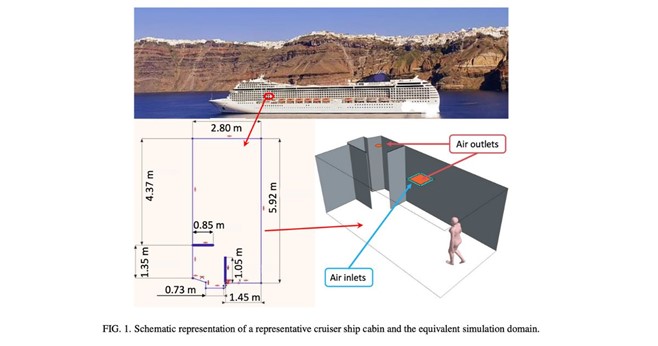The study published in Physics of Fluids suggests that simply higher ventilation rates do not result in safer cabin conditions for passengers and crew
UNIC researchers published a recent paper on cruise ship ventilation in the prestigious Journal of Physics of Fluids of the American Institute of Physics. The study sheds light on how viruses spread in cabins and other small spaces and suggests the best way to mitigate their spread.
The team compised Professor Dimitris Drikakis, Dr Ioannis Kokkinakis and Dr Konstantinos Ritos. The researchers examined how ventilation can affect the transmission of airborne viruses in a typical cruise ship cabin based on guidelines developed before and after the pandemic.
About the research
As COVID-19 initially swept across the world, its impact was notably profound within the realm of cruise ships. Remarkably, compared to various other groups, passengers aboard these vessels encountered a disproportionate infection rate, often finding themselves paradoxically marooned onboard for quarantine purposes. Consequently, considerable attention has been channelled towards addressing the imperative for enhanced ventilation systems on cruise ships. The effective dispersion of fresh air within cabins and enclosed areas is a crucial measure in curbing the transmission of viruses.
“The most recent standards and regulations on room safety regarding the airborne transmission of viruses focus on high rates of air exchange,” author Dimitris Drikakis is quoted saying in a press release by Physics of Fluids. “But this can be inefficient in terms of energy consumption, can compromise passenger comfort as it generates strong air drafts, and most importantly, can spread saliva droplets up to five times more when passengers cough.”
The research team conducted simulations for virus droplets from a cough in a typical cruiser cabin that accommodates two or more people, with different ventilation rates and positions of the person emitting the cough. Computational fluid dynamics testing ranged from 1.5 to 15 air changes per hour (ACH) to capture all possible scenarios, from minimal ventilation to rates exceeding the most recent recommendations.
“The study reveals that a higher ventilation rate is not the best strategy to avoid spreading airborne diseases,” Drikakis said to Physics of Fluids. “Complete evaporation of the saliva droplets may not necessarily mean all viruses or bacteria become instantly inactive. Therefore, we should aim at minimum droplet spreading inside the cabin and different ventilation strategies for occupied cabins.”
Upon reviewing the findings, the team concluded that the optimal utilization of ventilation systems involves maintaining medium flow rates at approximately 3 air changes per hour (ACH) while a cabin is occupied. This should then elevate to 15 ACH for at least 12 minutes after the cabin has been vacated. This approach ensures a complete refresh of the air for subsequent occupants. Additionally, the team suggests adhering to a similar minimum period of 12 minutes as a “clearance wait time” for rooms of comparable size equipped with a minimum of 15 ACH.
“Our main argument for the proposed values is the necessity to minimize droplet spreading while maintaining good ventilation levels, comfort and energy consumption,” said Drikakis. “Keeping ventilation at the proposed values reduces energy consumption and improves passenger comfort in contrast to higher ventilation rates.”
Source: University of Nicosia | News (https://shorturl.at/glBJ1)
